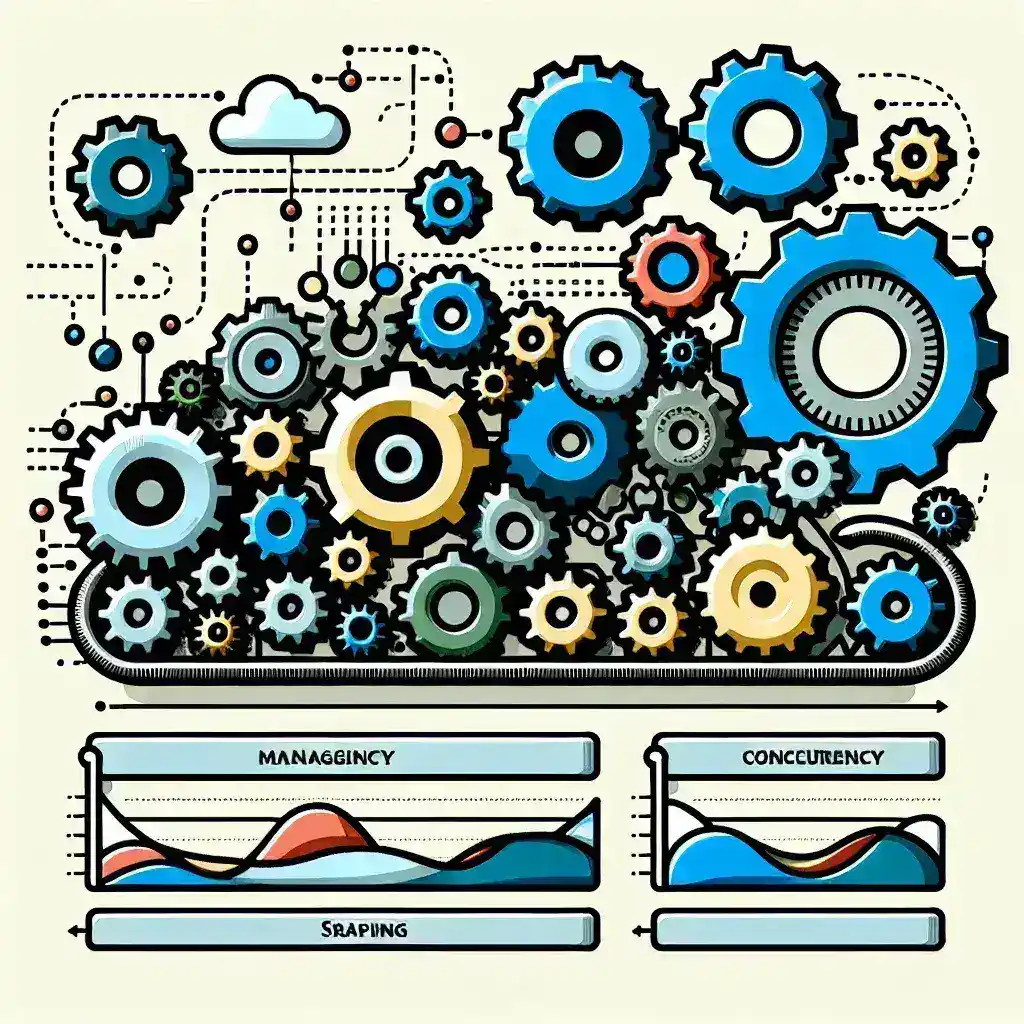Web scraping has evolved from simple sequential data extraction to sophisticated concurrent operations that can process thousands of requests simultaneously. As data demands grow exponentially, understanding how to effectively manage concurrency in scraping systems becomes crucial for developers and organizations seeking to extract information efficiently while maintaining system stability and respecting target website limitations.
Understanding Concurrency in Web Scraping Context
Concurrency in web scraping refers to the ability to execute multiple scraping operations simultaneously, rather than processing requests one after another. This approach dramatically improves throughput and reduces the overall time required to collect large datasets. However, implementing concurrent scraping requires careful consideration of various factors including server resources, target website limitations, and potential bottlenecks.
The fundamental challenge lies in balancing speed with responsibility. While concurrent requests can accelerate data collection, they can also overwhelm target servers, trigger anti-bot mechanisms, or exhaust system resources. Professional scrapers must navigate these complexities to build robust, efficient systems.
Threading vs. Asynchronous Programming Approaches
Two primary paradigms dominate concurrent scraping implementations: threading and asynchronous programming. Each approach offers distinct advantages and trade-offs that influence system architecture decisions.
Threading-Based Concurrency
Threading involves creating multiple execution threads that can run simultaneously, allowing different parts of the scraping process to execute in parallel. This approach works well for I/O-bound operations like web requests, where threads spend significant time waiting for network responses.
- Advantages: Familiar programming model, excellent for CPU-intensive tasks, straightforward debugging
- Disadvantages: Higher memory overhead, potential race conditions, Global Interpreter Lock limitations in Python
- Best suited for: Mixed workloads with both CPU and I/O operations
Asynchronous Programming
Asynchronous programming uses event loops to manage multiple operations without creating additional threads. This approach excels in handling numerous I/O-bound operations with minimal resource overhead.
- Advantages: Lower memory footprint, excellent scalability, no thread synchronization issues
- Disadvantages: Steeper learning curve, debugging complexity, single-threaded execution
- Best suited for: High-volume, I/O-intensive scraping operations
Rate Limiting and Throttling Strategies
Effective concurrency management requires sophisticated rate limiting mechanisms to prevent overwhelming target servers and avoid triggering defensive measures. Implementing proper throttling strategies ensures sustainable scraping operations while maintaining good relationships with data sources.
Token Bucket Algorithm
The token bucket algorithm provides a flexible approach to rate limiting by maintaining a virtual bucket of tokens. Each request consumes a token, and tokens are replenished at a predetermined rate. This method allows for burst traffic while maintaining overall rate limits.
Sliding Window Technique
Sliding window rate limiting tracks requests within a moving time window, providing more granular control over request distribution. This approach prevents request clustering and ensures more even traffic distribution over time.
Adaptive Rate Limiting
Advanced scraping systems implement adaptive rate limiting that adjusts request rates based on server responses, error rates, and response times. This dynamic approach optimizes performance while respecting server capabilities.
Connection Pooling and Resource Management
Efficient resource management forms the backbone of successful concurrent scraping systems. Connection pooling reduces the overhead of establishing new connections for each request while managing system resources effectively.
HTTP Connection Pools
Connection pools maintain a cache of reusable HTTP connections, significantly reducing the time and resources required for establishing new connections. Proper pool sizing balances resource utilization with performance requirements.
Session Management
Maintaining session state across concurrent requests requires careful coordination. Session pools can manage authentication tokens, cookies, and other stateful information across multiple concurrent operations.
Memory and Resource Monitoring
Concurrent scraping systems must continuously monitor resource utilization to prevent memory leaks, connection exhaustion, and system overload. Implementing proper monitoring and alerting mechanisms ensures system reliability.
Error Handling and Retry Mechanisms
Robust error handling becomes exponentially more complex in concurrent environments. Developing comprehensive strategies for managing failures, implementing intelligent retry mechanisms, and maintaining data consistency requires careful planning and implementation.
Exponential Backoff Strategies
Exponential backoff algorithms gradually increase retry delays to avoid overwhelming servers during temporary outages or high-load periods. This approach balances persistence with server respect.
Circuit Breaker Patterns
Circuit breakers prevent cascading failures by temporarily halting requests to failing services. This pattern protects both the scraping system and target servers during outage periods.
Dead Letter Queues
Failed requests can be routed to dead letter queues for later processing or manual investigation. This approach ensures no data is permanently lost while maintaining system performance.
Queue-Based Architecture Implementation
Queue-based architectures provide excellent scalability and fault tolerance for concurrent scraping systems. These systems decouple request generation from processing, enabling better resource utilization and system resilience.
Producer-Consumer Patterns
Producer-consumer architectures separate URL generation from request processing, allowing independent scaling of each component. This separation enables better resource allocation and system optimization.
Priority Queues
Priority-based queue systems ensure critical requests receive processing preference while maintaining overall system throughput. This approach optimizes resource allocation for time-sensitive data collection.
Distributed Queue Systems
For large-scale operations, distributed queue systems like Redis, RabbitMQ, or Apache Kafka provide robust, scalable foundations for concurrent scraping architectures.
Monitoring and Performance Optimization
Continuous monitoring and optimization ensure concurrent scraping systems maintain peak performance while adapting to changing conditions. Implementing comprehensive metrics and alerting systems enables proactive system management.
Key Performance Metrics
Essential metrics include request throughput, response times, error rates, resource utilization, and queue depths. These indicators provide insights into system health and optimization opportunities.
Bottleneck Identification
Regular performance analysis helps identify system bottlenecks, whether in network connectivity, CPU utilization, memory allocation, or external service dependencies.
Scaling Strategies
Understanding when and how to scale concurrent scraping systems ensures optimal performance as data requirements grow. Both vertical and horizontal scaling strategies have their place in system architecture.
Legal and Ethical Considerations
Managing concurrency responsibly involves understanding and respecting legal boundaries, website terms of service, and ethical scraping practices. Responsible concurrent scraping maintains sustainable access to data sources while avoiding legal complications.
Robots.txt Compliance
Respecting robots.txt directives and crawl delays demonstrates good faith efforts to follow website guidelines, even in concurrent environments.
Terms of Service Adherence
Understanding and complying with website terms of service prevents legal issues and maintains positive relationships with data providers.
Data Privacy Considerations
Implementing appropriate data handling and privacy protection measures ensures compliance with regulations like GDPR and CCPA.
Future Trends and Emerging Technologies
The landscape of concurrent scraping continues evolving with new technologies and approaches. Staying informed about emerging trends helps developers build future-proof systems.
Machine Learning Integration
AI and machine learning technologies increasingly influence scraping strategies, from intelligent rate limiting to predictive scaling and automated optimization.
Serverless Architectures
Serverless computing platforms offer new possibilities for scalable, cost-effective concurrent scraping implementations with minimal infrastructure management overhead.
Edge Computing Applications
Edge computing enables distributed scraping operations closer to data sources, reducing latency and improving performance for geographically distributed systems.
Successfully managing concurrency in scraping systems requires balancing multiple competing priorities: speed versus stability, efficiency versus responsibility, and complexity versus maintainability. By implementing robust architectures, monitoring systems continuously, and respecting ethical boundaries, developers can build scraping systems that deliver exceptional performance while maintaining long-term sustainability. The key lies in understanding that effective concurrency management is not just about technical implementation, but about creating systems that work harmoniously within the broader web ecosystem.

